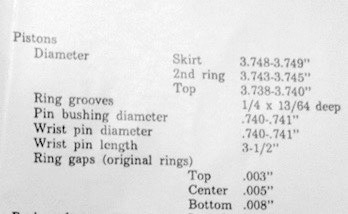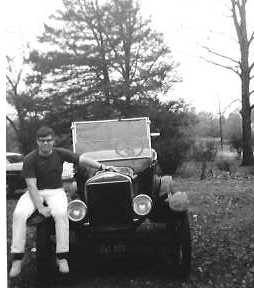Page 1 of 1
Piston size
Posted: Sun Jan 24, 2021 3:32 pm
by JoelBenoit
Hello. Just bought my first Model T in June, 2020, and I'm not a mechanic, so I'm looking for some help. Started getting a lot of oil in cylinder 4, so I'm going to change the piston rings. Took head off, and pistons are aluminum. I'm trying to determine which size of piston rings to buy. Lang's lists standard size pistons and then a number of oversized pistons, but it never states what diameter a standard size piston is. Does anyone know? I'd also like to know what the diameter of the original cylinder bore was. It is a 1925 Touring. Thanks
Re: Piston size
Posted: Sun Jan 24, 2021 4:38 pm
by Kerry
STD bore size is 3-3/4" (3.750) clean the top of the piston, they are usually marked as to what over size they are.
Re: Piston size
Posted: Sun Jan 24, 2021 4:42 pm
by George Hand
Joel, I believe you will find the blocks were bored to 3.750", standard pistons are usually marked std., .020 oversize would be 3.770, .030 would be 3.780, etc., also oversize pistons maybe marked on the edge of the top of the piston indicating the direction of installation instead of an ARROW pointing to the front of the block. Many times replacement pistons are used without concern for a worn taper in the cylinder wall & new rings will seal for a while. Cast iron pistons & rings will not leave a ring ridge as the top ring comes out of the cylinder a small amount leaving one to believe there is no wear in the cylinder because of the lack of a ring ridge. When in fact most of these 100 year old blocks have a measurable cylinder taper. Depending on how much you plan on driving you may have to make a decision on how far to go with a repair, maybe you have a broken ring or they could have been lined up rather than staggered. George
Re: Piston size
Posted: Sun Jan 24, 2021 5:10 pm
by JoelBenoit
If the original cylinder bore size is 3.75 inches, the original piston size would have to be a little smaller, I'd think. So, the question is, how much smaller is the original piston?
Re: Piston size
Posted: Sun Jan 24, 2021 5:48 pm
by DanTreace
Specifications from Ford Service School data, for motors made after 1913. Original std. size cast iron piston.

- Image 1-24-21 at 5.44 PM.jpeg (25.12 KiB) Viewed 3641 times
Re: Piston size
Posted: Sun Jan 24, 2021 5:53 pm
by Kerry
So you are asking for piston clearance, the only way you can measure that is to have the piston out, on a engine that has miles up on it and you are re- ringing then .006" on the thrust sides would be OK.
Re: Piston size
Posted: Sun Jan 24, 2021 5:57 pm
by Kerry
Dan, I've always considered those ring gap specs to be a misprint, they need to be reversed, the heat and hottest ring is always the top one and needs the larger clearance in any engine, even a compressor. And Joe, don't confuse your self with those specs, they are for the cast iron pistons, aluminium differ. you need about .012" on all ring gaps.
Re: Piston size
Posted: Sun Jan 24, 2021 8:09 pm
by Adam
Actually, the gap of each ring should be a bit larger than the one above it in order to properly relive pressure.
I do agree that the gaps in that chart are too tight.
Re: Piston size
Posted: Sun Jan 24, 2021 8:49 pm
by DanTreace
Frank
Thanks for clarification. Didn't read that detail, just cropped the specs and posted. So I added the ring gaps as noted in Ford Service book.remembered using those gaps when doing my first ring job in 1965.
The T smoked some and lacked a bit of power, so ordered a set of new std. size rings for cast pistons from J. C. Whitney! Pulled each and replaced the rings only. Followed the book and check the gaps to this spec. And ground the valves for good measure. T ran pretty good for a well used T!

- 1967 dan and t.jpg (25.11 KiB) Viewed 3563 times
So...changed that Ford Service Course date to use the specs in the Ford Service book.

- Cast Iron Piston.jpeg (27.8 KiB) Viewed 3563 times
Re: Piston size
Posted: Wed Jan 27, 2021 8:46 am
by JoelBenoit
Thanks for the info!
Re: Piston size
Posted: Wed Jan 27, 2021 11:36 am
by Adam
JoelBenoit wrote: ↑Sun Jan 24, 2021 3:32 pm
Started getting a lot of oil in cylinder 4, so I'm going to change the piston rings.
Oftentimes a lot of oil in a cylinder can also be due to worn valve stems and guides. If there is excessive clearance on the intake valve stem, there can be quite a bit of extra oil drawn into the cylinder from the valve gallery. I’ve worked on a couple cars where this was more of an issue than the rings.
Have you done a compression test?